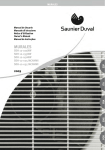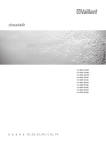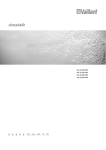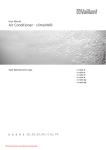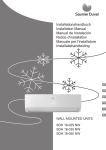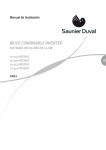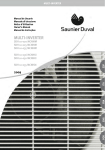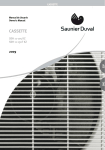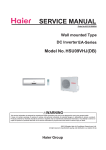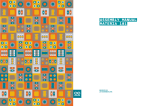Download Vaillant climaVAIR V 7-035NW Installation manual
Transcript
For the fitter Installation Manual Air-conditioner - climaVAIR Split Type V 7-025NW V 7-035NW EN Contents Contents 1 1.1 1.2 Your Safety . . . . . . . . . . . . . . . . . . . . . . . . . . . . 3 Symbols used . . . . . . . . . . . . . . . . . . . . . . . . . . . . . . . 3 Proper Use of the Unit . . . . . . . . . . . . . . . . . . . . . . . 3 2 Extreme Operating Conditions. . . . . . . . . . . . . 3 3 Identification of the Unit . . . . . . . . . . . . . . . . . 3 4 Declaration of Conformity . . . . . . . . . . . . . . . . 4 5 5.1 5.2 5.3 5.4 5.5 5.6 Description of the Unit . . . . . . . . . . . . . . . . . . . 4 Indoor Unit . . . . . . . . . . . . . . . . . . . . . . . . . . . . . . . . . 4 Outdoor Unit . . . . . . . . . . . . . . . . . . . . . . . . . . . . . . . . 5 Remote Controller . . . . . . . . . . . . . . . . . . . . . . . . . . . 6 Connections and Channels. . . . . . . . . . . . . . . . . . . . 6 Accessories . . . . . . . . . . . . . . . . . . . . . . . . . . . . . . . . . 6 Technical Specifications . . . . . . . . . . . . . . . . . . . . . . 7 6 Transport . . . . . . . . . . . . . . . . . . . . . . . . . . . . . . 8 7 Unpacking . . . . . . . . . . . . . . . . . . . . . . . . . . . . . 8 8 8.1 8.2 Installation. . . . . . . . . . . . . . . . . . . . . . . . . . . . . 8 Qualification of the Installation Personnel . . . . . . 8 General precautions to be taken into account before starting the installation . . . . . . . . . . . . . . . . 8 General Installation Diagram . . . . . . . . . . . . . . . . . . 9 8.3 9 9.1 9.2 9.3 9.3.1 9.3.2 9.3.3 9.3.4 9.3.5 9.3.6 10 10.1 10.2 10.3 10.4 11 11.1 11.2 11.3 11.4 11.5 2 12 12.1 12.2 12.3 12.4 Preparation for Use. . . . . . . . . . . . . . . . . . . . . 19 Checking for Leaks . . . . . . . . . . . . . . . . . . . . . . . . . 19 Purging the Installation . . . . . . . . . . . . . . . . . . . . . 19 Start Up . . . . . . . . . . . . . . . . . . . . . . . . . . . . . . . . . . 20 Troubleshooting . . . . . . . . . . . . . . . . . . . . . . . . . . . . 21 Installation of the Indoor Unit . . . . . . . . . . . . . 9 Selecting the Assembly Location . . . . . . . . . . . . . . 9 Fixing the Assembly Plate . . . . . . . . . . . . . . . . . . . . 9 Installation of the Pipes . . . . . . . . . . . . . . . . . . . . . 10 Methods for the Correct Discharge of the Condensed Water . . . . . . . . . . . . . . . . . . . . . . . . . . . 10 Handling the Coolant Pipes . . . . . . . . . . . . . . . . . . 10 Handling the Condensed Water Pipe . . . . . . . . . . . . 11 Making Holes for the Pipes . . . . . . . . . . . . . . . . . . 12 Laying the Pipes. . . . . . . . . . . . . . . . . . . . . . . . . . . . 12 Installation of the Indoor Unit Body . . . . . . . . . . . 13 Installation of the Outdoor Unit . . . . . . . . . . Selecting the Assembly Location . . . . . . . . . . . . . Planning the Coolant Return . . . . . . . . . . . . . . . . . Connection of the Coolant Pipes . . . . . . . . . . . . . Connection of the Pipe for the Removal of the Condensed Water . . . . . . . . . . . . . . . . . . . . . . . . . . . 13 13 14 14 Electric Wiring . . . . . . . . . . . . . . . . . . . . . . . . . Safety Precautions. . . . . . . . . . . . . . . . . . . . . . . . . . Remark with regard to Directive 89/336/EEC . . . . Electric Connection of the Indoor Unit . . . . . . . . Electric Connection of the Outdoor Unit . . . . . . . Electric Characteristics . . . . . . . . . . . . . . . . . . . . . . 15 15 16 16 17 18 15 Split Type Installation Manual Your Safety 1 Extreme operating conditions 2 Identification of the Unit 3 1 Your Safety 2 1.1 Symbols used This unit has been designed to operate within the range of temperatures indicated on Figure 2.1. Ensure that these ranges are not exceeded. Danger! Direct danger for life and health. Extreme Operating Conditions CROOLING EFRIGERACIÓN Danger! Danger of electric shock. Outdoor Exterior 18ºC 18ºCD.B. D.B. Note! Useful information and indications. This unit has been designed and manufactured for acclimatisation purposes by means of air conditioning. The use thereof for other domestic or industrial purposes shall be the exclusive responsibility of the persons projecting, installing or using them in that way. Prior to handling, installing, start up, using or performing maintenance on the unit, the persons assigned to perform these tasks should be familiar with all the instructions and recommendations set forth in the unit's installation manual. -7ºC D.B. -7ºC D.B. Indoor Interior Proper Use of the Unit 43ºC D.B. 43ºC D.B. 24ºC D.B.D.B. 24ºC Warning! Potentially dangerous situation for the product and the environment. 1.2 HCEATING ALEFACCIÓN 32ºC D.B. 32ºC D.B. 30ºC 30ºCD.B. D.B. 18ºC D.B.D.B. 18ºC 15ºC D.B. 15ºC D.B. Fig. 2.1 Operating ranges of the unit. Legend D.B. Temperature measured by dry bulb 3 Identification of the Unit This manual is valid for the Split Murales series. In order to know the specific model of your unit please refer to the unit nameplates. The nameplates are located on the outdoor and indoor units. Note! Keep the manuals throughout the service life of the unit. Note! The information relating to this unit is divided between two manuals: installation manual and user manual. Split Type Installation Manual EN 3 4 Declaration of Conformity 5 Description of the Unit 4 Declaration of Conformity The manufacturer declares that this unit has been designed and constructed in compliance with the standard in force with regard to obtaining the CE Marking. 5 Description of the Unit 5.1 Indoor Unit The indoor unit provides acclimatised air inside the room to be acclimatised. The dimensions and weights of the indoor unit are shown on Figure 5.2 and Table 5.1, depending on the model (please consult the model nameplate). The dimensions are given in mm. This unit is comprised of the following elements: - Indoor unit. - Outdoor unit. - Remote controller and holder. - Connections and channels. - Accessories. Figure 5.1 shows the unit components. Fig. 5.2 Dimensions of the indoor unit. Legend H Height L Length D Depth MODEL V 7-025 NWI V 7-035 NWI H 285 285 L 850 850 D 160 160 kg 10 10 Table 5.1 Dimensions and weights of the indoor unit. Fig. 5.1 Unit components. Legend 1 Indoor Unit 2 Outdoor Unit 3 Remote controller and holder 4 Connections and channels 5 Condensed water drainage pipe 4 Split Type Installation Manual Description of the Unit 5 5.2 Outdoor Unit The outdoor unit ensures that the absorbed air is released to the outside from the room during operation in cooling mode and that the heat introduced into the room during operation in heat pump mode is taken from the outside. The dimensions and weights of the outdoor unit are shown on Figure 5.3 and Table 5.2, depending on the model (please consult the model nameplate). The dimensions are given in mm. Fig. 5.3 Dimensions of the outdoor unit. Legend H Height L Length D Depth A Length of valves B Distance between valves C Distance from the second valve to the floor Air inlet Air outlet MODEL V 7-025 NWO V 7-035 NWO H 543 543 L 783 783 D 255 255 A 45 45 B 55 55 C 80 80 I 265 265 J 500 500 kg 30 30 Table 5.2 Dimensions and weights of the outdoor unit. Split Type Installation Manual EN 5 5 Description of the Unit 5.3 Remote Controller The remote control allows using the unit. 5.4 Connections and Channels This unit has the following connections and channels: - Gas (G) and liquid channels (L): they carry the cooling agent between the outdoor and indoor unit. - Discharge channels for condensed water (in the outdoor and indoor unit): they allow the water to be properly discharged which condenses during the normal operation of the unit. - Electric connections: they supply electric energy to the unit. 5.5 Accessories This unit is provided with the accessories shown on Table 5.3. No. Accessory Quantity Indoor Unit 1 Remote Control 1 2 Batteries 2 3 Mounting plate 1 4 Drain tubes 1 5 Piping support plate 1 6 Screw - Plastic cap 4 10 User Manual 1 11 Warranty cards 1 1 Cushion 1 2 Drain elbow 1 3 Installation Manual 1 Outdoor Unit Table 5.3 Accessories supplied with the unit. 6 Split Type Installation Manual Description of the Unit 5 5.6 Technical Specifications Power supply Cooling Capacity Power input Operating current Heating Capacity Power input Operating current Indoor Unit Air Flow volume Sound Power level Sound Pressure level Sound Pressure level min speed Dimensions (HxLxD) Net Weight Outdoor Unit Air Flow volume Sound Power level Sound Pressure level Refrigerant Refrigerant charge Compressor type Expansion system Dimensions (HxLxD) Net Weight Pipe Connections Diameter liquid/gas pipes Maxi piping length Max. height IU under OU Max. height OU under IU Chargeless lenght Additional charge per meter Units V/Ph/Hz kW kW A kW kW A V 7-025 NW 2.53 0.74 4.50 3.03 0.75 4.50 3.43 1.07 4.80 3.98 1.10 4.70 m3/h dB(A) dB(A) dB(A) mm kg 450 38 35 32 160x850x285 10 450 42 40 38 160x850x285 10 m3/h dB(A) dB(A) 2100 55 50 mm kg 1800 58 50 R410A 700 Rotary Capillary 543x783x255 30 543x783x255 30 Inches m m m m gr 1/4" - 3/8" 15 10 10 5 20 1/4" - 3/8" 15 10 10 5 20 gr V 7-035 NW 230/1/50 1000 Table 5.4 Technical specifications. Note! As part of its policy for ongoing improvements of its products, Vaillant reserves the right to modify these specifications without prior notice. Split Type Installation Manual EN 7 6 Transport 7 Unpacking 8 Installation 6 7 Transport 8 Installation Danger of injury and physical damage! During transport and unloading, the unit could fall and injure anyone within the immediate vicinity. To avoid this: - Use transport and lifting gear with suitable load capacity for the unit weight. - Use the transport and lifting gear correctly (consult the respective user manuals). - Use the slinging points provided for such a purpose on the unit. - Secure the unit correctly. - Use suitable personal protection equipment (helmet, gloves, safety boots and protective glasses). 8.1 Qualification of the Installation Personnel Unpacking Danger of injury and physical damage! During unpacking you could get cut and bruised. To avoid this: - Use lifting gear with suitable load capacity for the unit weight. - Use the transport and lifting gear correctly (consult the respective user manuals). - Use the slinging points provided for such a purpose on the unit. - Use suitable personal protection equipment (helmet, gloves, safety boots and protective glasses). Unpack the unit and check that: - The supply is complete. - All the elements are in perfect condition. Failing this, contact the manufacturer. Warning! Protect the environment. Dispose of the packaging following the local standards in force. Do not dispose of it without the proper controls. Ensure that this unit is installed by authorised personnel. The personnel authorised by Vaillant must be suitably qualified and able to install the unit correctly. 8.2 General precautions to be taken into account before starting the installation Danger of injury and physical damage! During unpacking you could get cut and bruised. To avoid this: - Use lifting gear with suitable load capacity for the unit weight. - Use the transport and lifting gear correctly (consult the respective user manuals). - Use the slinging points provided for such a purpose on the unit. - Use suitable personal protection equipment (helmet, gloves, safety boots and protective glasses). Danger of injury and physical damage! The unit should be installed in accordance with the Regulations and Standards for refrigerator, electrical and mechanical installation prevailing in relation to the location of such installations. Danger! Danger of electric shock. Connect the earth cable to the right line (not to the gas pipe, water pipe, lightning conductor or telephone line). Danger! Danger of electric shock. Install differentials to avoid short-circuits. Warning! Danger of breakdowns or malfunction. Use the pipes specifically intended for coolant for the cooling installation. Never use plumbing pipes. 8 Split Type Installation Manual Installation 8 Installation of the indoor unit 9 8.3 General Installation Diagram 9 Installation of the Indoor Unit Warning! Danger of breakdowns or malfunction. Observe the minimum assembly distances indicated in Figure 8.1. 9.1 Selecting the Assembly Location Warning! Danger of breakdowns or malfunction. Observe the minimum assembly distances indicated in Figure 8.1. Note! If a hole already exists in the wall or a coolant pipe or condensed water pipe has already been installed, the base plate can be mounted to adapt to these conditions. Recommendations - Install the indoor unit close to the ceiling. - Choose a mounting site that will allow air to reach all parts of the room evenly. Avoid beams, installations or lights which obstruct the airflow. - Install the indoor unit at an adequate distance from chairs or workstations in order to avoid unpleasant draughts. - Avoid close heat sources. 9.2 Fixing the Assembly Plate Carry out the steps described below: • Place the mounting plate on the chosen installation point. • Level the plate horizontally and mark the holes to be made on the wall for the installation using the screws and rawplugs. • Remove the plate. Fig. 8.1 General diagram of the installation and the minimum assembly distances. Legend 1 Indoor Unit 2 Outdoor Unit 3 Pipe for draining the condensed water A Front separation (minimum 10 cm) B Top separation in relation to the ceiling (minimum 5 cm) C Separation fixing wall (minimum 10 cm) D Height in relation to the floor (minimum 2 m) E Side separation opposite side connections (minimum 10 cm) F Rear separation (minimum 10 cm) G Side separation connections side (minimum 15 cm) H Front separation (minimum 60 cm) Split Type Installation Manual Warning! Danger of breaks in the domestic installation. Check that there are no electricity lines, pipes or any other element which could be impaired behind the spots where the holes are to be drilled. If so, choose another installation location and repeat the aforementioned steps.. • Make the holes using a drill and insert the rawplugs. • Place the assembly plate in the assembly location, level it horizontally and fix it with the screws and the rawplugs. Warning! Danger of breakdowns or malfunction. Ensure that the assembly plate has been correctly levelled. Otherwise, disassemble the plate and assemble it again correctly. EN 9 9 Installation of the indoor unit 9.3 Installation of the Pipes 9.3.1 Methods for the Correct Discharge of the Condensed Water Warning! Danger of breakdowns or malfunction. Danger of condensed water spillage. In order to ensure that the unit drains correctly take the requirements described in this section into account. Methods for the removal of the condensed water which is generated in the indoor unit: - Condensed water can be allowed to drain naturally using the natural tilt of the condensed water pipe along with the coolant pipe. In order for it to be aesthetically pleasing, use a joint channel. - The natural tilt of the condensed water pipe from the indoor unit to the container (washbasin, sink, etc.). Different invisible installation solutions also exist. - Using an external pump for condensed water, carrying the condensed water to the outside or to the house drainage system. - By natural tilt to the collector deposit for condensed water which is emptied using a pump for condensed water. The pump for condensed water receives a signal from the tank and takes the water from the tank conveying it to the outside or to the house drainage system. Note! This pump for condensed water is available as an original Vaillant accessory with the corresponding installation instructions. Warning! Danger of breakdowns or malfunction. Danger of condensed water spillage. To ensure that the unit carries out the drainage properly in the event of draining using a natural tilt, the condensed water pipe must also have a tilt from the indoor unit. 10 9.3.2 Handling the Coolant Pipes Danger! Danger of burns and eye injuries. In the event of soldering, use suitable protection equipment (protective soldering mask, soldering gloves, solderer clothing). Warning! Danger of breakdowns or malfunction. Danger of wear in the coolant pipes. To ensure that the coolant pipes do not wear take the following points into consideration: - Use pipes specifically intended for cooling. Note! In specialised dealers you will find coolant pipes which are thermally insulated as a Vaillant accessory. - Ensure that the pipes are clean, dry and polished on the inside. - The insulation of the pipes should be done using specific insulation for cooling. - Observe the minimum and maximum pipe distances for each model. - Do not bend the pipes where possible. When bending them, keep the radius as wide as possible to minimise load losses. - If soldering, do so using strong welding (copper-silver alloy). During the soldering process a stream of dry nitrogen should be run through the inside of the pipes in order to avoid rusting. - Only cut the coolant pipes using pipe cutters and always keep the pipe ends covered. - Any flaring work should be performed meticulously in order to avoid subsequent losses of gas through the pipes. - When reviving keep the pipe opening directed downwards in order to prevent shavings from getting into the pipes. - Mount the joining tubes carefully, ensuring they cannot become displaced. Ensure that they will not cause traction in the joins. - Equip the coolant pipes (inflow and outflow) separately and with thick diffusion heat insulation. - Carefully squeeze the flaring connector, centring the flaring cone and the flanged nut. Applying excessive force without correctly centring can damage the thread and cause a reduction in the water tightness in the join. Split Type Installation Manual Installation of the indoor unit 9 9.3.3 Handling the Condensed Water Pipe Warning! Danger of breakdowns or malfunction. Danger of incorrect drainage of the condensed water and wear of materials due to dripping water. Take the following points into consideration: - Ensure that air circulates through the condensed water pipe in order to guarantee that the water can be freely released. Otherwise, the condensed water could leak through the indoor unit body. - Mount the pipe without bending it in order to avoid blockage. - If the water pipe is channelled outdoors, ensure that it is insulated against freezing. - If the condensed water pipe is installed in a room, fit thermal insulation. - Avoid installing the condensed water pipe with an ascending bend (see Figure 9.2). Fig. 9.4 Avoid crimping. - Install the condensed water pipe in such a way that the distance of its free end from the floor is at least 5 cm (see Figure 9.5). Fig. 9.5 Minimum distance from the floor. Fig. 9.2 Avoid ascending bends. Legend H Minimum distance from the floor: 5 cm - Avoid installing the condensed water pipe with it free end submerged in water (see Figure 9.3). - Install the condensed water pipe in such a way that its free end is kept away from unpleasant odours to ensure that they do not penetrate the room (see Figure 9.6). Fig. 9.3 Avoiding submerging the end. - Avoid installing the condensed water pipe with crimping (see Figure 9.4). Split Type Installation Manual Fig. 9.6 Avoids unpleasant odours. EN 11 9 Installation of the indoor unit 9.3.4 Making Holes for the Pipes 9.3.5 Laying the Pipes • Case A: laying the rear piping. In the event of laying the rear piping, a suitable hole must be made (see Figure 9.1). • Drill a hole in accordance with the diameter indicated in Figure 9.1, slightly descending to the outside. • If installing the rear piping: • Place the lid supplied for the hole in the piping and insert the coolant pipes with the condensed water pipe through the hole. • Seal the hole properly after installing the pipes. • Carefully bend the installation pipe in the right direction. Warning! Danger of breakdowns or malfunction. Danger of wear in the coolant pipes. Bend the pipe carefully to prevent choking or breaks. Fig. 9.1 Dimensions of the hole for the piping. • Case B: laying the side or bottom piping. In this case holes do not have to made on the wall since the indoor unit body has windows which can be opened to admit the pipes: choose the most adequate one for the desired outlet position (see Figure 9.7). • Carefully break the chosen window on the lid using pliers. • Cut the pipes, leaving enough extra piping hanging over to enable the unit to be hooked up at the indoor unit joins. • Insert the nut in the coolant pipe and carry out the flaring. • Carefully remove the insulation of the flared connections in the indoor unit. • Hang the indoor unit on the top edge of the mounting plate. • Tilt the lower part of the indoor unit forwards and insert an auxiliary tool (e.g. a piece of wood) between the mounting plate and the unit (see Figure 9.8). Fig. 9.8 Assembling the indoor unit. Fig. 9.7 Windows for the installation of the pipes. Legend 1 Lid for right piping 2 Lid for indoor piping 3 Securing with adhesive tape 4 Lid for left piping 12 • Connect the coolant pipes and the condensed water hose to the corresponding pipes and installation drain. • Insulate the coolant piping correctly and separately. To do so, cover any possible cuts with masking tape or insulate any bare coolant piping with the corresponding insulation material used for cooling. Split Type Installation Manual Installation of the indoor unit 9 Installation of the outdoor unit 10 10 Installation of the Outdoor Unit 10.1 Selecting the Assembly Location Danger of personal injury and material damage from explosion! Install the unit away from gases or inflammable or easily combustible substances and free from thick dust formation. Fig. 9.9 Laying the Pipes. Legend 1 Heat-resistant material 2 Drain pipe 3 Coolant pipe 4 Piping support plate 5 Indoor/outdoor electric cable • Insert the electric piping, connect the line on the indoor unit terminal strip and assemble the cabling covering (see section 11). • Carry out the start up and the equipment functional test (see section 12). • Fix the entire indoor unit (see section 9.3.6). Note! The connections in the flaring should be accessible in order to carry out the water tightness tests. • Install the mounting plate, lining up the holes with the help of the plate. 9.3.6 Installation of the Indoor Unit Body • Check that the installation has been carried out correctly and that there are no leaks (see section 12.1). • Securely hang the indoor unit body onto the upper notches of the mounting plate. Briefly move the body from side to side to verify that it is secure. • Lift the body up slightly from underneath, press it onto the mounting plate and then lower it vertically. The body will fit into the lower supports on the mounting plate. • Check that the indoor unit is properly secured. • In the event that the body does not slot into the supports properly, repeat this process. Split Type Installation Manual Danger of personal injury and material damage from collapse! Ensure that the ground can withstand the weight of the outdoor unit and allow it to fit in a horizontal position. Warning! Danger of corrosion. Do not install the unit near to corrosive materials. - The outdoor unit can only be mounted outdoors, never inside a building. - Do not install the unit in such a way that the air current affects the air inlets of premises nearby. - If possible avoid direct sunlight. - Ensure that the ground has sufficient rigidity to avoid vibrations. - Check that there is sufficient space to observe the minimum distances (see Figure 10.1). - Check that neighbours are not disturbed by draughts or noise. - If the premises are rented obtain the owner's consent. - Comply with local regulations: there are considerable differences depending on the area. - Leave enough space to fit the condensed water drainage pipe (see section 10.4). EN 13 10 Installation of the outdoor unit 10.2 Planning the Coolant Return The coolant circuit contains a special oil to lubricate the outdoor unit compressor. To assist the return of the oil to the compressor the following is recommended: - that the indoor unit is located higher than the outdoor unit and, - that the suction pipe (the thickest one) is assembled with the tilt towards the compressor. If the outdoor unit is mounted higher than the indoor unit, the suction pipe must be mounted in a vertical position. At heights exceeding 7.5 m: • An additional oil deposit should be installed at each 7.5 m interval to collect the oil and suction it, returning it to the outdoor unit and • An elbow can be installed in front of the outdoor unit to further assist the oil return. 10.3 Connection of the Coolant Pipes Note! Installation is easier if the gas suction pipe is connected up first. The suction pipe is the thickest one. • Mount the outdoor unit in the designated site. • Remove the protection hoods from the coolant joints in the outdoor unit. • Carefully bend the installed pipe towards the outdoor unit. Fig. 10.1 General diagram of the installation and the minimum assembly distances. Legend 1 Indoor Unit 2 Outdoor Unit 3 Pipe for draining the condensed water A Front separation (minimum 10 cm) B Top separation in relation to the ceiling (minimum 5 cm) C Separation fixing wall (minimum 10 cm) D Height in relation to the floor (minimum 2 m) E Side separation opposite side connections (minimum 10 cm) F Rear separation (minimum 10 cm) G Side separation connections side (minimum 15 cm) H Front separation (minimum 60 cm) 14 Warning! Danger of breakdowns or malfunction. Danger of wear in the coolant pipes. Bend the pipe carefully to prevent choking or breaks. • Cut the pipes, leaving enough extra piping hanging over to enable the unit to be hooked up at the outdoor unit joins. • Flare the coolant pipe when installed. • Join the coolant pipes to the corresponding outdoor unit connection. • Insulate the coolant piping correctly and separately. To do so, cover any possible cuts with masking tape or insulate any bare coolant piping with the corresponding insulation material used for cooling. Split Type Installation Manual Installation of the outdoor unit 10 Electric Wiring 11 10.4 Connection of the Pipe for the Drainage of the Condensed Water Note! Applicable only to those units that have built-in heat pumps. Whilst the unit is running with the heat pump function, condensation forms in the outdoor unit and has to be drained. • Insert the elbow included in the supply in the hole provided at the bottom of the outdoor unit and turn it 90º to fix it (see Figure 10.2). 11 Electric Wiring 11.1 Safety Precautions Danger! Danger of electric shock. Before connecting the unit to the electric supply line, ensure that the line is not live. Danger! Danger of electric shock. If the mains cable is damaged, it must be replaced by the manufacturer, the head of maintenance or a similarly qualified person. Danger! Danger of electric shock. Ensure that the power line is equipped with a bipolar or tetrapolar switch according to the model, (single phase or three-phase) with a distance of at least 3 mm between contacts (Standard EN-60335-2-40). Fig. 10.2 Assembly of the drainage elbow for condensed water Legend 1 Outdoor Unit 2 Drainage elbow 3 Drainage hose • Mount the drainage hose ensuring that it leaves the equipment at a tilt. • Verify the correct drainage of the water by pouring the water into a collection tray located at the bottom of the outdoor unit. • Protect the condensed water hose with thermal insulation to avoid freezing. Danger! Danger of electric shock. Equip the installation with protection against short-circuits to avoid electric shocks. This is a legal requirement. Danger! Danger of electric shock. Use an electric plug which perfectly adapts to the electric power supply wiring. Danger! Danger of electric shock. Use wiring in accordance with the respective local, national and international wiring standards regarding installation in technical electrics. Danger! Danger of electric shock. Use an approved electric plug and power supply cable. Split Type Installation Manual EN 15 11 Electric Wiring Warning! Danger of breakdowns or malfunction. Size the electric wiring with sufficient capacity. Warning! Danger of breakdowns or malfunction. Compliance with the Standard EN 61000-3-11: Check that the nominal power of the main phase current connection is > 100. 11.3 Electric Connection of the Indoor Unit Warning! Danger of breakdowns or malfunction. If the fuse on the PC board is blown please change it with type T. 3,15A/250V. • Disassemble the outdoor body of the indoor unit by pulling it upwards. • Remove the wiring cover on the right of the body by unscrewing it (see Figure 11.1). Warning! Danger of breakdowns or malfunction. Ensure that the supplied power voltage is in the range of 90% to 110% of the rated voltage. Warning! Install the unit in such a way that the electric plug is easily accessible. Thus, if required, the unit can be quickly disconnected. Fig. 11.1 Wiring Cover. 11.2 Remark with regard to Directive 89/336/EEC In order to prevent electromagnetic interference during the start up of the compressor (technical process), the following installation conditions must be adhered to. • Make the air conditioning unit power supply connection at the main power distribution. Carry out the distribution with low impedance. Normally the required impedance is reached at a 32 A fusing point. • Check that no other equipment is connected to this power supply line. • Insert the cable from the outside: • Using the same hole through which the coolant pipes are installed (or are going to be installed later) or, • Using another of the pipe installation windows provided on the body. • Pull the electrical cable from the rear of the indoor unit through the specific hole in the front. • Connect the line on the terminal strip of the indoor unit according to the corresponding wiring diagram (see Figures). Note! For more detailed information on the electric installation, please consult the Technical Connection Conditions applied by your electricity supply board. Note! In order to obtain more information with regard to power details of the air conditioner consult the unit rating plate. 16 Split Type Installation Manual 1 �������� �������� Electric Wiring 11 ������� ������� ������� ������� ������� ������� ������� ������� ������� 1 ������� ������� ������� 2 2 Fig. 11.2 Wiring indoor unit, model V 7-025 NW and V 7-035 NW. Legend 1 Strip for the indoor unit 2 Strip for the outdoor unit • Check that the cables are properly fixed and connected, position the wiring cover and mount the outside body. • Models V 7-025 NW and V 7-035 NW are equipped with a plug in the indoor unit. 11.4 Electric Connection of the Outdoor Unit Warning! Danger of breakdowns or malfunction. If the fuse on the PC board is blown please change it with type T. 25A/250V. • Remove the protective covering in front of the electrical connections in the outdoor unit. • Loosen the screws in the bushing block and fully insert the cable terminals of the power supply line in the bushing block and tighten the screws. Warning! Danger of malfunction and breakdowns resulting from water penetration. Mount the power cable below the bushings using a cable loop in order to avoid water penetration. Warning! Danger of malfunction and breakdowns resulting from short-circuits. Insulate the unused cable wires using masking tape and ensure that they cannot come into contact with low voltage parts. • Secure the cable installed with the outdoor unit's contracting device. • Check that the cables are correctly secured and connected. • Mount the protective wiring cover. Split Type Installation Manual EN 17 11 Electric Wiring 11.5 Electric Characteristics Voltage Outdoor Unit section up to 2 meter Outdoor Unit section up to 25 meter Interconnect section up to 2 meter Interconnect section up to 25 meter Indoor Unit section up to 2m Indoor Unit section up to 25m Thermal-magnetic circuit breaker, type D Outdoor Unit Thermal-magnetic circuit breaker, type D Indoor Unit Inmediate residual current protector V 7-025 NW 230/1/50 Hz INTERCONNECT INTERCONNECT 1 1.5 PLUG 1.5 10 10 0.03 A V 7-035 NW 230/1/50 Hz INTERCONNECT INTERCONNECT 1 1.5 PLUG 1.5 10 10 0.03 A Table 11.1 Electric Characteristics. 18 Split Type Installation Manual Preparation for Use 12 12 Preparation for Use 12.2 Purging the Installation This consists of the following steps: • Checking for Leaks. • Purging the installation. • Start up. • Troubleshooting. 12.1 Checking for leaks 12.2 Purging the installation Legend 1 Suction valve (gas) 2 Return valve (liquid) 3 Combined meter 4 Non-return joint 5 Pipes for coolant 6 Vacuum pump for coolant Fig. 12.1 Checking for leaks in the installation. Legend 1 Suction valve (gas) 2 Return valve (liquid) 3 Combined meter 4 Non-return joint 5 Pipes for coolant 6 Nitrogen cylinder • Connect a combined meter (faucets) to the three-way valve in the suction hose. • Connect a nitrogen cylinder to the low-pressure end of the combined meter. • Carefully open the valves corresponding to the faucets and pressurise the system. • In the event of using R-410A coolant set it to 40 bar(g) of pressure, for 10/20 min. • Check that all the connections and joints are watertight. • Close all the valves on the combined meter and remove the nitrogen cylinder. • Release the pressure from the system by slowly opening the faucets. • In the event of detecting leaks, repair them and repeat the test. • Connect a combined meter (faucets) to the three-way valve in the suction hose. • Connect a vacuum pump to the low-pressure end of the combined meter. • Ensure that the faucets are closed. • Turn the vacuum pump on and open the vacuum valve, the low valve on the combined meter and the gas faucet. • Ensure that the high valve is closed. • Leave the vacuum pump functioning for approximately 15 minutes (depending on the size of the installation) to carry out the vacuum. • Check the needle on the low pressure manometer: it should indicate -0.1 MPa (-76 cmHg). Fig. 12.3 Low pressure manometer reading with the low valve open. Split Type Installation Manual EN 19 12 Preparation for Use • Close the low valve on the combined meter, disconnect the vacuum pump and close the vacuum valve. • Check the manometer needle after approximately 1015 minutes have elapsed: the pressure should not rise. If it does rise, there are leaks in the circuit: repair them (check the joints, joins, the indoor and outdoor parts and the technical service faucets). Fig. 12.6 Opening of the two and three-way valves. Legend 1 Two-way valve 2 Three-way valve 3 Actuation faucets • Cover the two and three-way valves with the corresponding protective covers. Fig. 12.4 Low pressure manometer reading with the low valve closed: checking for leaks. Warning! Danger of malfunction and leaks. Ensure that the service valves are closed. 12.3 Start Up Fig. 12.7 Protective covers. Legend 1 Service hole lid 2 Two and three-way valve covers • Connect the unit and run it for a few moments checking that it carries out its functions correctly (for more information see the user manual). Fig. 12.5 Filling the installation. Legend 1 Two-way valve 2 Actuation faucet • Open the two-way valve by twisting the rod 90º anticlockwise and close it after 6 seconds. The installation will be filled with coolant. • Check the installation again for tightness: • If there are leaks see section 12.4. • If there are no leaks, continue. • Remove the combined meter with the joining hoses and faucets. • Open the two and three-way valves by twisting the rod anticlockwise as far as it will go. 20 Split Type Installation Manual Preparation for Use 12 12.4 Troubleshooting If the event of a gas leak, proceed as follows: • Purge the installation removing the coolant by pumping. - You need a suction pump and a recycling bottle. Warning! Never dump coolant into the environment! Coolant is a harmful product for the environment. • Check the flaring joins. • Repair the leak, replace indoor and outdoor parts which are not tight. • Fill the unit with the correct amount of coolant using coolant scales. • Proceed to check for leakage as described above. Split Type Installation Manual EN 21






















